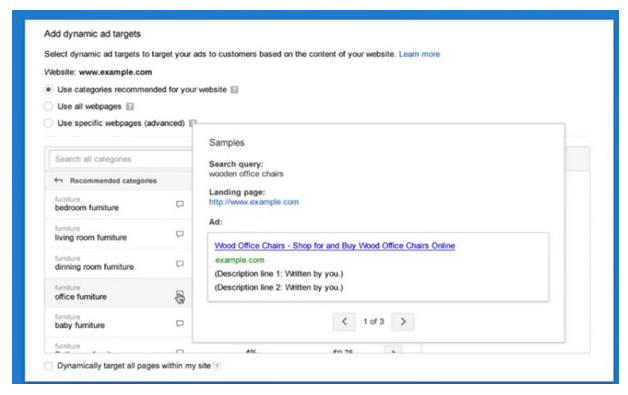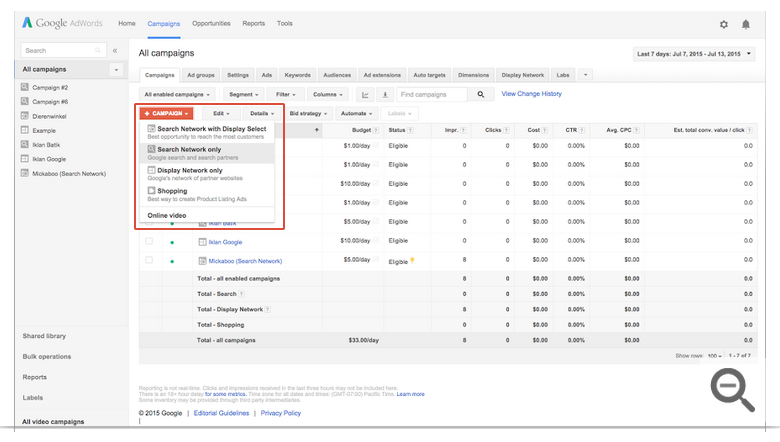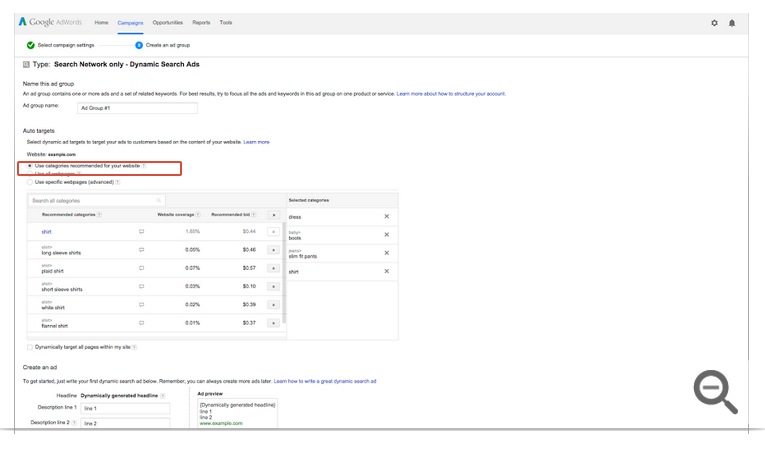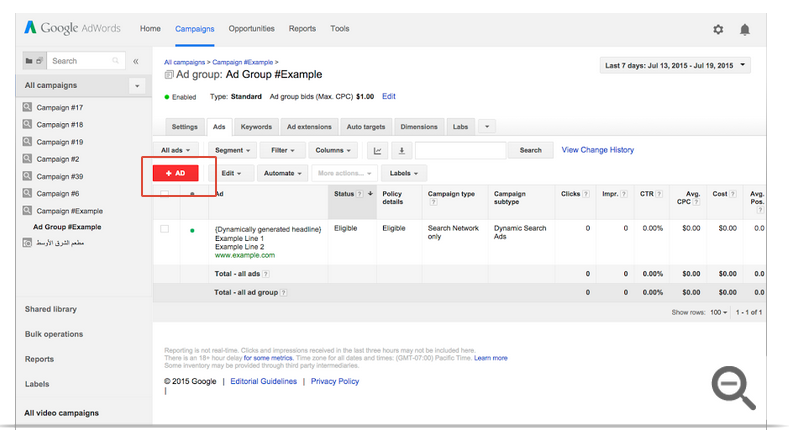How Retailers Can Optimize Campaigns With Dynamic Search Ads


Dynamic Search Ads use Google’s organic web crawling technology to automatically target relevant search queries based on a retailer’s website content.
Dynamic Search Ads are useful for campaigns because they:
Retailers with “content-rich” websites will see the best results from using Dynamic Search Ads.
Dynamic Search Ads benefit:
When Google finds searches that are a match for Dynamic Ad targets, it generates the ad headline and landing page URL. This URL is linked to the most appropriate page from a retailer’s website.
The headline is dynamically created from each matching phrase entered in Google Search, and from the title of the most relevant landing page used for the ad. Dynamic Search Ads can have longer headlines than other search ads, which improves their visibility and marketers can control the description lines and display URL in the ads.
Earlier this year, Google upgraded Dynamic Search Ads with recommended category targets based on a retailer’s website content, suggested CPCs for every category and more visibility into the ads that will show and pages where customers will land.

 “Google’s definitely trying to make it easier for advertisers to scale. Improvements to dynamic search ads, display auto re-sizing, and improvements to bid automation within AdWords really highlight that movement,” Roman Fitch, Retail Search Manager at CPC Strategy said.
“Google’s definitely trying to make it easier for advertisers to scale. Improvements to dynamic search ads, display auto re-sizing, and improvements to bid automation within AdWords really highlight that movement,” Roman Fitch, Retail Search Manager at CPC Strategy said.
Although the program was already in existence, these latest updates have made it all the more robust and easier to use.
“For the Dynamic Search Ads – categories are already pre-filled that match your site. Before, marketers use to build these out individually. Another cool thing is they give you CPC estimates. I wouldn’t trust them completely, but at least a good benchmark to keep in mind.”
1. Improves Efficiency
Dynamic Search Ads pull relevant data from Google’s organic search index. This trims down the amount of time retail marketers have to spend building out keywords, bids and ad text for each product on the site.
2. Automatic Ad Updates
When a retailer makes changes to their page, Google will automatically crawl the website to make sure they are harvesting the most recent, updated version of the website.
3. Dynamically Generated Headlines
According to Google, when a customer’s search is relevant to a product or service, they will dynamically generate an ad with a headline that includes words from that customer’s search phrase and the landing page in the ad.
Dynamic Search Ads also include a generated headline that is slightly longer than standard text ads, giving the ad increased visibility & relevance for shoppers.
4. Campaign Control
With Dynamic Search Ads, retailers have the option to based their ads on their entire website, or hone in on specific categories or pages. They can also prevent ads from showing for products that are temporarily out-of-stock.
5. Traffic Increase
[bctt tweet=”One of the most influential benefits of Dynamic Search Ads is traffic increase. “]This potential increase in traffic can lead to an increase in sales. The more retailers invest in optimizing their campaign, the more customers they can reach.
 “Advertisers can take advantage of Google’s improving Dynamic Search algorithms to drive high-quality traffic to the most relevant landing pages at a cheaper cost,” Lewis Brannon Paid Search Manager at CPC Strategy said.
“Advertisers can take advantage of Google’s improving Dynamic Search algorithms to drive high-quality traffic to the most relevant landing pages at a cheaper cost,” Lewis Brannon Paid Search Manager at CPC Strategy said.
“Also, advertisers are able to more quickly and efficiently scale their campaign builds without having to labor over keyword research and building long keyword lists. It has traditionally worked well as a “fill-in-the-gaps” type of campaign, and can still be used effectively in this way, but recently we have seen solid results using this campaign type as a primary campaign type, even replacing some keyword targeted campaigns.”
So, are there any reasons why a retailer might want to avoid Dynamic Search?
“Absolutely – a major requirement for effective performance on DSA is having a well-structured website. The most effective campaign structure that we have tested so far is based on site categories and sub-categories, which Google pulls directly from your site structure,” he said.
“A clean, intuitive site structure lends itself well to building a DSA campaign and segmenting it categorically. This will allow you to set bids, write effective ad copy, and use negative keywords optimally. However, the lack of a clean site structure can have major negative implications for the quality of your DSA campaign and will most likely lead to undesirable ad impressions and landing page decisions by AdWords.”
Retailers can select whether they want to pull details from their entire website or only specific pages to target their ads. Currently, the default to set up Dynamic Search Ads is to use category targets (generated from the retailer’s website). Typically, based on the structure and depth of content on the retailer’s website, DSA will help reach groups of people “who are most relevant for their business goals”.
Example: Retailers segment their categories based on the items they sell (shirts, shoes, pants).
Retailers can also leverage advanced options for Dynamic Search targets including:
The ranking of Dynamic Search Ads is determined in the same way as keyword based ads. According to Google AdWords, both are based on the maximum cost-per-click (CPC) bid specified for the dynamic ad target and the dynamic search ad’s auction-time measurement of Quality Score (using the same calculations that are used with other search ads).
What if a user’s search exactly matches a keyword in your keyword-based campaign?
In this situation, the ad from a keyword-based campaign will show instead of the dynamic search ad, as long as the two ads belong to the same AdWords account, or to different accounts belonging to the same advertiser if the accounts are linked.
Control:
Reporting:
To use Dynamic Search Ads, choose the “Search Network only – Dynamic Search Ads” campaign type.
Note: If you want to use additional features (like the Audience tab), which are only available in the “All features” campaign type, you can configure a Dynamic Search Ads campaign under that campaign type as well.
1. Sign in to your AdWords account.
2. Click the Campaigns tab.
3. Click the +Campaign drop-down menu and select Search Network only.

4. On the Select campaign settings page, choose Dynamic Search Ads. Then enter your campaign name.
5. In the Dynamic Search Ads section, enter your domain and the language corresponding to the pages you want your ads to target.
6. Fill in all the additional settings, including target geographic locations, budget, and default bid. In the bid configuration section, click Advanced Options. Choose an automated bidding strategy if you want Google to optimize your bids. We recommend automated bidding for use with Dynamic Search Ad campaigns as it can provide better performance than manual cost-per-click (CPC) bidding.
7. Click Save and continue.
1. In the Name this ad group section, name your ad group.
2. To target by categories (which is recommended): In the Auto targets section, choose Use categories recommended for your website.

3. Select categories and add them to the Selected categories column. You can see sample pages and ads for each category by hovering over the dialog icon to the right of the category name.
4. To target all webpages on the site, select Use all webpages.
5. To target only certain webpages, select Use specific webpages (advanced).
6. In the Create an ad section, enter the text for the first and second description lines of the ad. The headline will be generated dynamically. Also enter the URL (your domain) that you want displayed in the ad.
7. If retailers want to track their ad performance, they will need to use the Ad URL options section, where you can insert ValueTrack parameters in the URL tracking template.
8. Click Save ad group.
9. If you like, add more ad groups from the Ad groups tab of your campaign.
With a Dynamic Search Ad campaign, retailers can have more than one ad, which means they can collect data on which ad is most effective.
To add more Dynamic Search Ads to the ad group of the campaign created:

In summary, Fitch offers a concise roundup of his expert insight for retailers using DSA:
For more on how to leverage Dynamic Search Ads email [email protected]
[bctt tweet=”What are Dynamic Search Ads?”]
[bctt tweet=”Google Announces Updates to Dynamic Search Ads”]
[bctt tweet=”5 Reasons Why Retailers Should Use Dynamic Search Ads”]
